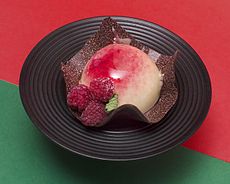- Custard
-
This article focuses on egg-thickened custards. For versions based on "custard powder" and their derivatives, see Bird's Custard."egg custard" redirects here. For the egg custard tart, see egg custard tart.For other uses, see Custard (disambiguation).
Custard is a variety of culinary preparations based on a cooked mixture of milk or cream and egg yolk. Depending on how much egg or thickener is used, custard may vary in consistency from a thin pouring sauce (crème anglaise), to a thick pastry cream used to fill éclairs. The most common custards are used as desserts or dessert sauces and typically include sugar and vanilla. Custard bases may also be used for quiches and other savory foods. Sometimes flour, corn starch, or gelatin is added as in pastry cream or creme patissiere. Custard is usually cooked in a double boiler (bain-marie), or heated very gently in a saucepan on a stove, though custard can also be steamed, baked in the oven with or without a water bath, or even cooked in a pressure cooker. Custard preparation is a delicate operation, because a temperature increase of 5–10 °F (3-6 °C) leads to overcooking and curdling. Generally, a fully cooked custard should not exceed 80 °C; it begins setting at 70 °C.[1] A water bath slows heat transfer and makes it easier to remove the custard from the oven before it curdles.[2]
Contents
History
Mixtures of milk and eggs thickened by heat have long been part of European cuisine. Custards baked in pastry (custard tarts) were very popular in the Middle Ages, and are the origin of the English word 'custard': 'croustade' originally referred to the crust of a tart.[3] Examples include Crustardes of flessh and Crustade, in The Forme of Cury. These recipes include solid ingredients such as meat, fish, and fruit bound by the custard.[4][5] Stirred custards cooked in pots are also found under the names Creme Boylede and Creme boiled.[5]
In modern times, the name 'custard' is sometimes applied to starch-thickened preparations like blancmange and Bird's Custard.
Custard variations
While custard may refer to a wide variety of thickened dishes, technically (and in French cookery) the word custard (crème or more precisely crème moulée, [kʁɛm mule]) refers only to an egg-thickened custard.
When starch is added, the result is called pastry cream (French: crème pâtissière, pronounced: [kʁɛm patisjɛːʁ]) or confectioners' custard, made with a combination of milk or cream, egg yolks, fine sugar, flour or some other starch, and usually a flavoring such as vanilla, chocolate, or lemon. Crème pâtissière is a key ingredient in many French desserts including mille-feuille (or Napoleons) and filled tarts. It also used in Italian pastry and sometimes in Boston cream pie.
When gelatin is added, it is known as crème anglaise collée ([kʁɛm ɑ̃ɡlɛz kole])
When starch is used alone as a thickener (without eggs), the result is a blancmange. In the United Kingdom, custard often refers to a dessert thickened from cornflour (cornstarch) rather than eggs; see custard powder.
After the custard has thickened, it may be mixed with other ingredients: mixed with stiffly beaten egg whites and gelatin, it is chiboust cream; mixed with whipped cream, it is crême légère, [kʁɛm leʒɛːʁ].
Savoury custards
Not all custards are sweet. A quiche is a savoury custard tart. Some kinds of timbale or vegetable loaf are made of a custard base mixed with chopped savoury ingredients. Custard royale is a thick custard cut into decorative shapes and used to garnish soup, stew or broth. Chawanmushi is a Japanese savoury custard, cooked and served in a small bowl or on a saucer.
Custard may also be used as a top layer in gratins, such as the South African bobotie and many Balkan versions of moussaka.
Uses
Recipes involving sweet custard are listed in the custard dessert category, and include:
- Crema Catalana
- (Egg) Custard tart, also called egg custard.
- Egg tart
- English trifle
- Flan
- Taiyaki
- Vanilla slice
- Vla
- Zabaglione
Physical properties
Cooked (set) custard is a weak gel, viscous and thixotropic; while it does become easier to stir the more it is manipulated, it does not, unlike many other thixotropic liquids, recover its lost viscosity over time.[6]
A suspension of uncooked custard powder (starch) in water, with the proper proportions, has the opposite rheological property: it is negative thixotropic, or dilatant, which is to say that it becomes more viscous when under pressure. This suspension is termed oobleck and often used in science demonstrations of non-Newtonian fluids. The British popular-science programme Brainiac: Science Abuse demonstrated dilatancy dramatically by filling a swimming pool with this mixture and having presenter Jon Tickle walk across it;[7] this was called "walking on custard."
References
- ^ Barham, Peter (2001). The science of cooking. Berlin: Springer. p. 126. ISBN 3-540-67466-7.
- ^ McGee, Harold (1984). On Food and Cooking. p. 71. ISBN 0-684-18132-0.
- ^ Oxford Companion to Food, s.v. 'custard'
- ^ Hieatt, Constance, and Sharon Butler. Curye on Inglysch: English culinary manuscripts of the fourteenth century (including the forme of cury). London, EETS SS 8, 1985.
- ^ a b Austin, Thomas, ed. Two Fifteenth-Century Cookery Books. London, EETS OS 91, 1888, repr. 1964; referring to Harleian MSS 279 and 4016.
- ^ Karla Longrée, Sharie Beaver, Paul Buck, Joseph E. Nowrey, "Viscous Behavior of Custard Systems", Journal of agricultural and food chemistry 14:6:653 (1966), pubs.acs.org
- ^ Brainiac: Science Abuse (unknown episode).
Categories:- Food ingredients
- Custard desserts
- Egg dishes
Wikimedia Foundation. 2010.


